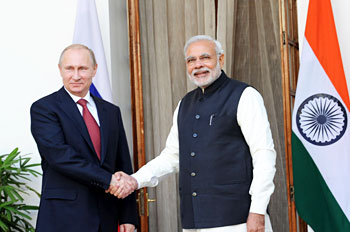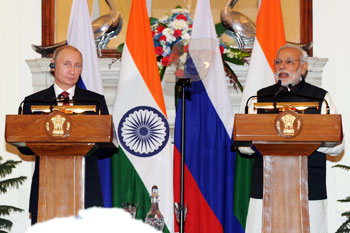INDIAN ARMED FORCES CHIEFS ON
OUR RELENTLESS AND FOCUSED PUBLISHING EFFORTS

SP Guide Publications puts forth a well compiled articulation of issues, pursuits and accomplishments of the Indian Army, over the years

I am confident that SP Guide Publications would continue to inform, inspire and influence.

My compliments to SP Guide Publications for informative and credible reportage on contemporary aerospace issues over the past six decades.
India Russia - Half Hearted Druzhba?

The Joint India Russia Statement titled, “Druzhba-Dosti: A Vision for strengthening the Partnership over the next decade' promises a lot, reflecting the traditional strong strategic ties between the two Eurasian and Asian giants but it has also ruffled a few feathers in many capitals of the world and the most significant reaction was of the US State Department over the President Putin’s high profile visit to India. The US side asserted that it was not the right time for business as usual with Russia. Commenting on Putin’s less than 24 hour visit to India from 10th to 11th December, an annual summit ritual which Putin performs in a hurried manner, the US Spokesperson Marie Harf said, “our view remains that it’s not time for business as usual with Russia, given its action in Ukraine.

Since Russia is under heavy sanction by the US and EU for its support of pro_Moscow rebels in Eastern Ukraine as well as Russia’s annexation of the Ukrainian peninsula of Crimea, they expect India to join the western bandwagon. The mandarins in South Block were well aware of the impending reaction in Western Capitals, especially in view of India’s recent efforts to improve its relations with the US and its allies. Since Russia is presently on a sticky wicket, suffering from a battered economy due to western sanctions, Putin was more than willing to go extra miles to reassure India over its strategic partnership with India. On the other hand the umbilical chord of India’s armed forces is tied with Russian defence industry, which cannot be ignored, hence Modi assured Putin, “Even as India's options have increased today, Russia will remain our most important defence partner. We have conducted joint exercises across all three wings of the Armed Forces in the last six months and also revealed, “We also discussed how to align our defence relations to India's own priorities, including Make in India.” Modi thus underlined the primacy of Moscow in India’s strategic calculus. Modi said these words even when Russia has ignored protestations from India over Russia’s latest defence cooperation agreement with Paksitan, which envisages transfer of Mi-35 attack helicopters to the Pakistan, ostensibly to help Pakistan army fight the terrorists and insurgents on its western border.
Off course India could not have protested beyond a limit as Indian armed forces are critically dependent on Russian defence industry for maintaining its combat edge over the neighbors. President Putin proudly reminded the Indian media that Russia had extended significant assistance in developing and manufacturing the Brahmos supersonic Cruise missile, which in the age of Missile Technology Control Regime, none of Indian western strategic partners would have shared the know how. Also, India cannot be blind to the sensitive technical assistance in the field of nuclear submarine Arihant and two more of the same class. Brahmos has provided Indian armed forces a significant offensive capability, which should not be sidestepped. Similarly the Sukhoi-30MKI fighters have bridged the critical combat capability gap of the Indian armed forces. Many other Class defence systems from Russia have formed the backbone of Indian military, but lack of spare support has bedeviled the armed forces. So, Prime Minister Modi correctly proposed to his Russian friend, “that Russia should locate manufacturing facilities in India for spares and components for Russian defence equipment in India.” Putin responded very positively to his request.
There was no direct mention of the progress on the Fifth Generation Fighter Project but these issues were discussed during the talks, over which India has expressed resentment. The Russian ambassador Alexander Kadakin had revealed a few days earlier that the Russian side is ready for fifty — fifty work share and the fighter project would not be delayed beyond 2018, discounting media reports that the IAF would not be receiving the first squadron of FGFA before 2022-23.
Even this highly ambitious project is under discussion, the Russian President offered to manufacture the Russia’s most advanced military helicopter gunship in India under Modi’s Make in India policy. Besides defence, the two sides issued a Joint Statement asserting the political will of the two states to further strengthen the special privileged partnership between the two powers, which said, “the special and privileged strategic partnership between India and Russia has been built on the strong foundation of mutual trust, bilateral understanding and unique people-to-people affinities, the leaders emphasized that the time has come for a significant broad-basing of bilateral cooperation to carry the friendship between the countries to a qualitatively new level.”
Diplomatic observers opined that these are mere rhetorical statements, which does not match with the Russian deeds, which has supplied not only advanced defence technology and defence systems to China, India’s principal rival but even has begun talking to Pakistan which India considers as unfriendly act. But these well meaning words in the Joint Statement create confusion in US and western capitals which wants to draw India away from the Chinese and Russian influence.
However India has to ignore the western sensitivities in view of India’s huge energy demand and Russia appears to be emerging as principal energy partner. The vision document titled the. “Strategic Vision for Strengthening Cooperation in Peaceful Uses of Atomic Energy Between the Republic of India and the Russian Federation is a testimony to this. Russia has abundant energy and India’s appetite for energy is ever growing in view of its fast rising economy. Hence it was extremely significant that the Russian side offered to build more than 20 nuclear power plants in India. This offer has come at a time when India’s principal nuclear energy partner US, Japan and France are asking for a relaxed nuclear liability law. After several years delay, the Russia side has agreed to start construction work of the unit 3 and 4 of the Kudankulam nuclear power plant. Russia was initially offered a nuclear park in Haripur in West Bengal but due to noncooperative attitude of West Bengal government., Russians could not commence the work. The new site for nuclear power plants will be allotted soon, where a series of nuclear power plants will be constructed according to the roadmap drafted in March, 2010. The nuclear cooperation between the two countries have emerged one of the largest globally, which the rest of the world is taking note of. Especially the US and Western world feels cheated as they helped India join the international nuclear mainstream, but all the nuclear commerce is going to the Russians, ignoring the nuclear liability concerns. The Russians are also seriously supporting the case for India’s membership of the four restrictive export control regimes i.e. the Nuclear Supplier Group, The Wassenar Arrangement, the Australia Group and the Missile Technology Control Regime, a move being staunchly opposed by China.





